
In recent years, the value of dairy farming has been substantially increasing. A proper environmental control system for dairy animals has become crucial for evaluating dairy quality. Dairy animals suffer from backlashes of ecological changes in general and effects of low temperatures, sudden temperature changes, stray air currents, and heat stress due to excess humidity in specific.
One of the most essential variables restricting production efficiency is the climatic condition. Dairy farmers all over have understood the importance of a well-managed and structured environmental control system and its increasing importance.
The environmental control system has become a proven solution for managing damages incurred through climatic conditions. Heat and moisture generation rates at predetermined ambient temperature levels can be used to manage the environment in dairy animal housing systems, thereby facilitating environmental, physiological, and behavioural aspects to be monitored automatically and regularly.
The current availability of technical breakthroughs, including intelligent sensors, detectors, analysers, cameras, and microphones, can permit comprehensive dairy management systems based on constant, real-time control and monitoring of productivity, animal welfare and health, and environmental circumstances. Dairy farmers can use such monitoring systems to detect heat stress, illness, or air quality issues in real-time and take appropriate action.
Also, read…
Strategies for Managing Heat Stress in Dairy animals
To optimize and improve animal well-being and output while also extending the structure’s life, a need for a robust building environmental control system is evident. Ventilation extra heaters for cold situations and cooling devices for hot ones are the most common methods of ecological change.
Humidity, moisture, air velocity, and airborne pollutants are just a few critical environmental factors that a well-structured ecological control system can control. On the other hand, the ideal environmental variables vary depending on the local and regional temperature, site layout and infrastructure, dairy animal population, and production phase. Ventilation systems and heating or cooling demands are established based on heat and moisture loads to properly regulate environmental factors inside the facility.
To guarantee that animals receive adequate care inside commercially successful enterprises, contemporary dairy farming facilities are required to monitor environmental conditions and animal behaviour and health.
The environmental control system has not become an epitome in the dairy industry to describe dynamic behaviour change in dairy animals and to optimize the production level. The drawbacks of environmental changes can only be eradicated through proper Environmental control management.
Cost-effective Environmental control system for monitoring, recording, and analysing parameters such as body temperature, moisture, and behaviour that works well in hostile settings, is non-invasive and capable of operating autonomously and constantly needs to be created, refined, or verified.



















